We've not really moved very far today. Zittau is only sixteen kilometres further down the road from yesterday's campsite. We stopped here as we needed money, fuel and internet access before continuing into Poland.
This quiet town of 30,000 inhabitants really is at the junction of the three countries of Germany, the Czech Republic and Poland. The border controls form a triangle where, if you fancied driving the guards demented, you could spend all day going around the loop, in and out of all three countries.
This morning we parked Modestine by the river and walked in through the hot streets of this little old town with its huge cobbled market square in front of the massive 19th century town hall, edged on all sides by shops occupying the ground floor of large 17th century houses.
 Market square, Zittau
Market square, Zittau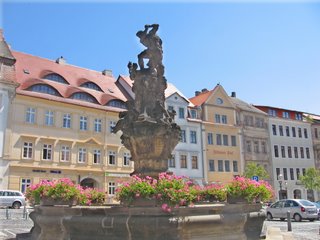 Hercules Well, Neustadt, Zittau
Hercules Well, Neustadt, ZittauWhile the centre is undoubtedly attractive, our walk in took us through the edge of the old town. Here the streets are deserted and run down. Buildings that had once been quite beautiful were left to decay during the days of the DDR and no suitable use has been found for them since. So they have had a further seventeen years to decay. Though many are still occupied, most stand abandoned, windows broken, plaster falling from the walls, paintwork blistered and grass growing from gutters and drainpipes.
 Character homes available, need some work, Zittau
Character homes available, need some work, ZittauGradually the town has been improved and restored but it is still most definitely an East German town, dilapidated by contrast with the west of the country but with a great deal of character. There is very little traffic on the cobbled streets.
At the Deutsche Bank the cash machine took our card, processed it and returned it. It then failed to give us the money we had requested! Fortunately the bank was open and a check by staff showed the transaction had not registered. It seems banks here still have intermittent trouble with their electricity supplies and ours is not an uncommon experience! We eventually got some money from a different machine. It was fortunate Ian was able to explain the problem to the bank staff. If it had been in Poland we wouldn't have had a clue about the language!
On the town square we discovered a shop selling bread, cakes and ice cream alongside fresh meat products, sausages, Schnitzels, gherkin salads and hot lunches. There were people standing at high bars around the walls eating coffee and cake while next to them stood others eating soup and cooked meals. We joined then for really excellent cheap meals of pork casserole with potatoes and mixed vegetables eaten standing between counters full of spare ribs and kidneys to our right and Apfelstrudel and Heidelbeerkuchen to our left! We were fortunate to find a ledge to perch on as we ate. Most people simply had to stand. Such shops, known as Stehcafés, are very common and we had already experienced one in Weimar so knew what to expect.
People in the former DDR are reputed to suffer quite badly from "Ostalgie", when they recall some of the products they used to have before reunification that are no longer obtainable today. This is usually foodstuffs but can be anything. Our friend Hubert has been known to cycle for miles to a baker who still produces bread rolls as they used to be twenty years ago. Today Ian had a touch of Ostalgie when he caught a whiff of smoke from the little railway station where a Dampflok (steam locomotive) was being hooked up to some carriages. Until relatively recently steam trains were normal in the DDR, running on brown coal (lignite), belching out great clouds of polluting smoke that suffocated the lungs and blackened the absorbent sandstone statues and facades of buildings.
The countryside of East Germany is criss-crossed with narrow gauge railway tracks and many are still operated using steam, though nowadays proper coal is used. They cross the roads without any barricades, just a warning light. Jill hates crossing these tracks and doesn't trust the lights. Today though we were not driving and Ian was able to indulge his yearning to travel in an open carriage behind a little steam train pouring out black smoke as it slowly trundled along the single track through birch and oak woods up into the sandstone mountains of the Zittau range. The train to Oybin was preparing to leave Zittau, so without a second thought Ian eagerly climbed aboard the little Bimmelbahn and off we went.
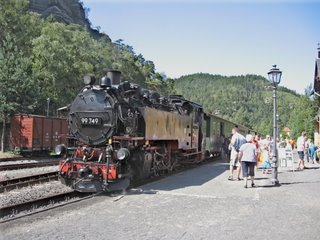 Dampflok about to depart
Dampflok about to depart Ian wallows in Ostalgie
Ian wallows in Ostalgie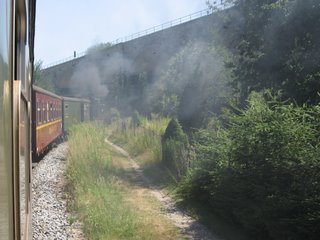 Climbing up to the woods
Climbing up to the woods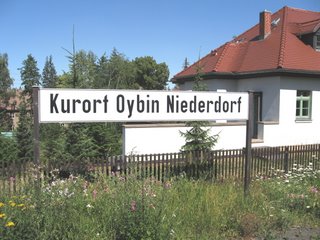 A rural station on the way to Oybin
A rural station on the way to OybinIt took nearly an hour to chuff our way up into the hills with Ian standing on the open footplate at the end of the carriage or eagerly leaning over the side to see the engine on the curves. It was a truly pretty ride and at the end we were further rewarded with two hours in the delightful village of Oybin set beneath a huge outcrop of sandstone with a castle on the summit. (Haven't they all?) Here Ian really pushed his luck by dragging Jill up the steep rocky path, through a narrow gorge and up a slippery track strewn with tree roots. Just below the summit we discovered a ticket office! Four euros each to see the castle! We didn't want to see the castle, only the view. Why couldn't there have been a notice at the bottom of the climb warning of charges?
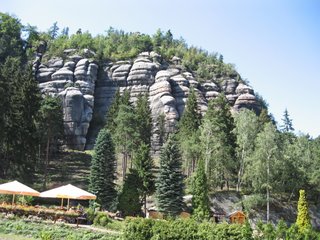 Sandstone rocks at Oybin
Sandstone rocks at Oybin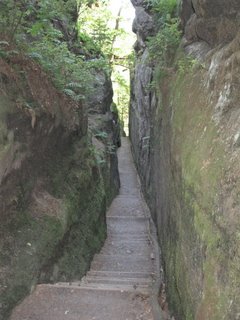 A natural split in the rock provides access to the castle, Oybin
A natural split in the rock provides access to the castle, OybinWe didn't go in but discovered a little path through a tumbling chaos of rocks that looked really picturesque so our climb wasn't wasted. We also discovered a pretty little 18th century church with a painted and decorated wooden interior nestling beneath the rocks. We could see why this spot was so popular with Romantic artists and writers in the 19th century.
 Romantic rocks and cool shade, Oybin
Romantic rocks and cool shade, Oybin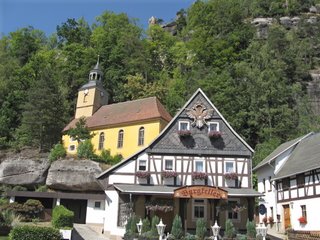 Church on the rocks, Oybin
Church on the rocks, Oybin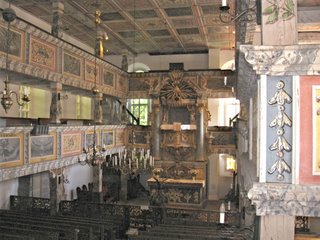 Church interior, Oybin
Church interior, Oybin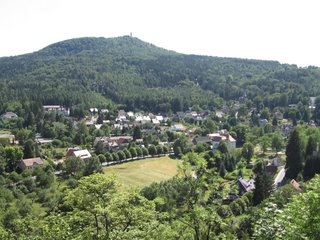 Oybin seen from the rocks
Oybin seen from the rocks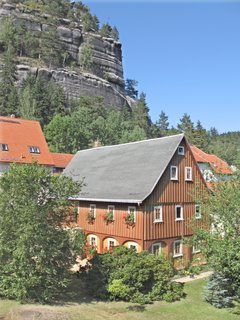 Village house beneath the rocks, Oybin
Village house beneath the rocks, Oybin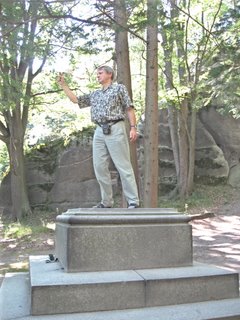 Ian takes the place of a fallen hero of the DDR
Ian takes the place of a fallen hero of the DDRWhen we returned to the village we rewarded ourselves for our climb with ice creams on a bench in the shade by the lake as we watched the huge fish swimming and speculated that they had probably been there since DDR days when the water would not have been as clean for them as it is now.
On the return journey passengers were being served with beer in the open top carriages. Most appeared to be local people and were permanently waving to friends and neighbours as we passed. Within the villages children ran beside the train waving and calling up and as we passed allotments with their little wooded summer houses people would cheer and wave their own beer glasses to the train passengers. One man watering his beans beside the track cheerfully turned his hose on us all. As we were all far too hot in the open carriages nobody minded at all.
 Waving to friends as the train returns to Zittau
Waving to friends as the train returns to ZittauSo Ian had his day of nostalgia. It was gone 6pm by the time we were back and we still had to find where we had left Modestine. After some difficulty we eventually discovered a campsite on a lake just outside the town. It's a new site with no tree cover, just acres of dry parched yellow grass and baking sun but it will have to do for tonight. We'll need to move off early tomorrow though; generally it's already hot by 7am.
As we sheltered from the setting sun with glasses of wine on the shady side of Modestine a couple of very nice German people came up to ask if they could see inside and to wonder at how compact she is. It's the second guided tour we've done today and even Jill can do it almost word perfect in German now! They were a very nice couple from Berlin who drove a Citroen Berlingo and were tickled to discover one made into a camping car and amazed we'd been living in such a tiny home together with a couple of bikes and a computer for nearly a year! Ian welcomes these opportunities to use German and invariably the conversations lead on to other topics. It's a sociable way to spend half an hour of an evening and good practice for Jill's comprehension.
Tuesday 18th July 2006, Niesky, Oberlausitz, East Germany
We left the campsite as early as we could this morning as we were woken by the sun around 6am. By the time we left the glare and heat had become unbearable. As we paid our bill there was a curious incident. According to the campsite records someone stayed at the site this time last year. He came from the Czech Republic and was called Philip Maxted! We have no knowledge as to who he might be and Maxted is not a common name.
Back in Zittau we visited the Church of the Holy Cross where a lenten veil is displayed. It seems that in mediaeval times it was common practice to hide the altar with a large sheet of material during lent. The one used at Zittau had been painted in 1472 with ninety scenes taken from the old and new Testaments with short inscriptions in German underneath each one. This was a way of teaching the faithful to understand their Bible and was contemporary with the Biblia pauperum blockbooks. Today it would lend itself wonderfully to being scanned and made available in electronic format. As we looked at it, with the images laid out in ten rows with nine pictures to a row our fingers were almost searching for the button to see each image in a larger size! Unfortunately we were not allowed to take any photos for the blog. During the war it was hidden away but discovered by Russian soldiers stationed nearby in 1945. Unaware of its significance, they cut it into pieces and used it as a cover for their outdoor sauna! It was only in recent years that it turned up again, badly damaged and in several pieces. Its value as a piece of mediaeval cultural history was recognised and money was raised to restore it so that once again it could hang in one of the Zittau churches. It certainly is a fascinating item, reputed to be the largest single piece of medieval painted fabric in Europe. In some ways it is Germany's answer to the Bayeux Tapestry.
Leaving Zittau behind, we followed a broken and potholed side road the few yards to the Polish border. It was actually right beside the railway track we travelled along yesterday. Either side of this road the buildings stood abandoned, derelict and decaying.
On the Polish side it was even worse! There had been no attempt to repair the road which was dangerously pitted and the general state of neglect everywhere was quite distressing. From the very little we have seen today we have the impression that Poland has adapted to the post Soviet period far less easily than has the Czech Republic. The roadside near the border was lined, as in the Czech Republic, with stalls of cheap junk, drinks, cigarettes and motor spares. Here though the stalls were run by Polish people rather than Chinese. We don't know why or how so many Chinese came to be in the Czech Republic while we have seen none in Poland.
We did not intend travelling far into Poland so simply followed the route for twenty five kilometres up to Zgorzelec. We were delighted when we finally arrived in one piece with Modestine's axles still intact. At the beginning there was no traffic at all coming the route from the border. Either side of the road silver birch trees masked areas of sand excavation and graveyards for rusting pieces of factory machinery for which nobody had any further use. Huge pipelines ran alongside the road, crossing it on raised gantries. Massive conveyor belts stood idle in front of disused factories and amidst it all blocks of flats had been erected. With the sun beating down it seemed so sad to see young mums pushing prams along dusty unmade pavements across empty spaces between the flats. The essentials they need are all there but so long after the Change we have the impression that much remains to be done before people here have an equal living standard with western EU countries.
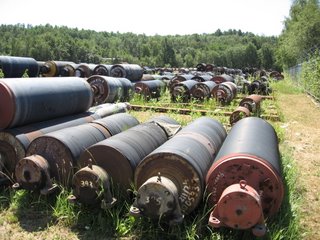 Abandoned and rusting machinery parts, Poland
Abandoned and rusting machinery parts, Poland Cooling towers and factory chimneys, Lomnica, Poland
Cooling towers and factory chimneys, Lomnica, PolandOnce we joined the major roads we found driving standards very poor and quite dangerous. Road signs are often obliterated and frequently ignored by many drivers who will overtake on blind bends using their horns to warn everyone that they are coming through. It was quite a frightening experience even after driving so many kilometres across Europe over recent months.
Zgorzelec is a town divided. On one side of the river Neisse it belongs to Poland, on the other side to Germany where it is called Görlitz. We were particularly interested to visit this town, having seen it on our previous visit to this area of Germany in 1973. On that occasion the town struck us as one of the saddest places we had ever seen. It had once been a beautiful old town full of mediaeval houses of outstanding architectural value and large squares with fountains and arcades. When we were there,
(on the East German side, we were not allowed to cross the river) it was in complete decay after years of neglect from the DDR regime following the war. The blackened buildings were crumbling, falling down even. They were dangerously unsafe with weeds growing profusely from roof gutters, tiles missing, rafters slipped and gaping holes in the roofs. Windows were left hanging with broken glass in the streets. The smell of burning lignite hung in the air and amidst it all people continued to live a drab existence hemmed in by state-imposed regulations with little to hope for in the future.
We wanted to see what changes had taken place since 1989 and greatly feared we would find the town worse than ever. Of course we arrived on the Polish side at Zgorzelec where it was indeed rather drab and in a state of decay. At the bridge we crossed into the German side and found somewhere to park. It was a complete transformation! We are so glad we visited the town again. Like a phoenix it has risen from the ashes of the past and once again it is a stunningly beautiful town, full of light, colour and architectural splendours that quite take your breath away. The people on the Polish side are now free to cross the river and can see just how different Gorlitz is from Zgorzelec. Sadly, "Poles apart" is a very apt way of describing the two halves of this little town. There are signs though that improvements are beginning to be made though in the short term this is making the town an even more unbearable building tip in which to live.
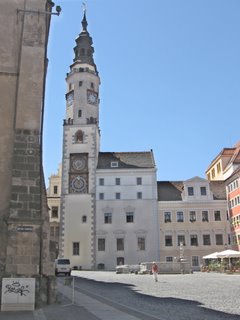 Rathaus, Görlitz
Rathaus, Görlitz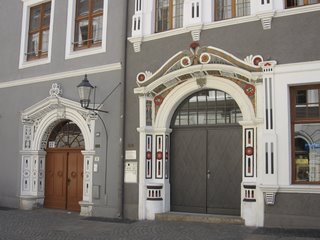 Restored doorway, Görlitz
Restored doorway, Görlitz Obermarkt, Görlitz
Obermarkt, Görlitz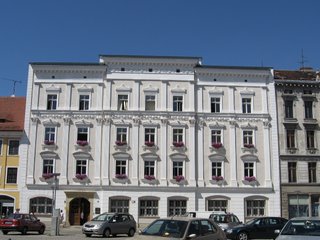 Restored to its former beauty, Görlitz
Restored to its former beauty, Görlitz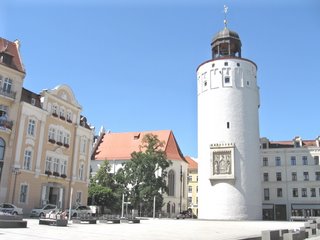 Dicker Turm on the Marienplatz, Görlitz
Dicker Turm on the Marienplatz, Görlitz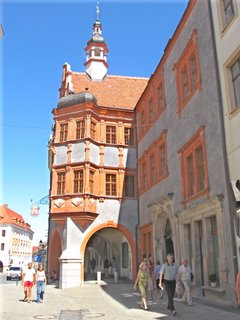 Schönhof, built 1526, Görlitz
Schönhof, built 1526, GörlitzIn Görlitz we wandered the streets, seeking the shadow of the buildings to stand to admire the wonderful restorations in the Upper and Lower Markets. We visited the library of the Oberlausitz Scientific Society, established in 1779 and now with over 100,000 volumes. They had to unlock the room especially for us. It was set up to support the work of this very active provincial academy and, with its tall bookshelves arranged in arches, it seems like an amalgamation of the Devon and Exeter Institution and the Devonshire Association - the Society even published transactions until World War 2. The collections on regional history are still actively maintained. Next to it was the town museum where one room was given over to the rather frightening apparatus used by A.T.von Gersdorf, one of the founders of the Society, in his late 18th century experiments on the medical applications of electricity. He was much influenced by the work of Joseph Priestley in England. The museum also included examples of Bohemian glass, Meissen porcelain and locally produced blue glazed folk ceramics. In addition there were examples of local furniture decorated with hand-painted folk designs.
 Library of the Oberlausitz Scientific Society, Görlitz
Library of the Oberlausitz Scientific Society, Görlitz Inside the museum, Görlitz
Inside the museum, Görlitz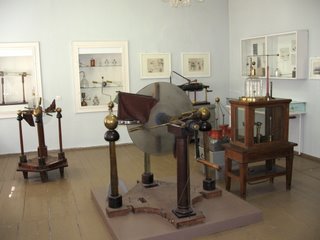 Early instruments for generating static electricity, Görlitz
Early instruments for generating static electricity, Görlitz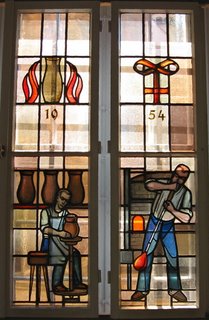 Socialist era stained glass window showing local industries of ceramics and glass blowing, Görlitz
Socialist era stained glass window showing local industries of ceramics and glass blowing, GörlitzLater, in the Trinity Church where we went to admire the simple wooden interior with painted decoration on the walls, ribbed vaulting and balconied seating, we were offered coffee and cakes in the refectory. Several young students served us at a table laid with the lovely blue folk art cups and saucers. Such an unexpected experience added greatly to our pleasure. When we had finished and asked for the bill we were told it was free! So we left a suitable sum in the church collecting box instead. There was a little exhibition on in the church concerning the Hungarian king Matyas Corvinus, organised jointly by young people in Germany and Rumania so we assume the refreshment was intended to encourage visitors.
 Our coffee table in the church, Görlitz
Our coffee table in the church, GörlitzSince visiting the museum in Comacchio, Italy, we have been noticing manhole covers in many of the towns we have visited and were very happy to discover Görlitz has one of its own design.
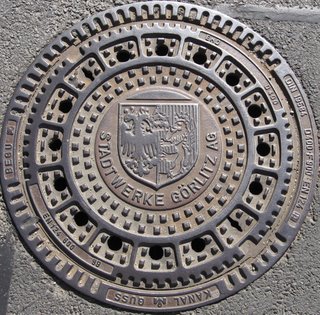 Manhole cover, Görlitz
Manhole cover, GörlitzWe then wondered whether there may be different ones on the Polish side of the town so walked down to the footbridge to cross back into Poland. This bridge turned out to be at a particularly desolate point of entry into Zgorzelec and the two customs officials were taken aback when they checked our British passports. Explaining we wouldn't be long and were just looking for a good manhole cover to photograph they let us through and watched suspiciously as we examined the manholes scattered around the wasteland on the far side of the river. Here the streets have been stripped down and hopefully new roads will soon be laid. In the meantime all the manholes stand about six inches proud of the street, many without covers. None had anything worth photographing however so we returned past the bemused customs officials and made our way back to Modestine.
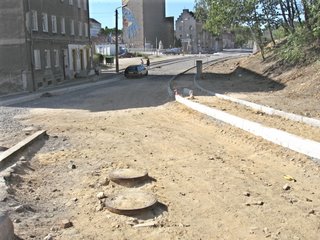 Unsuccessful manhole cover hunt in Zgorzelec
Unsuccessful manhole cover hunt in Zgorzelec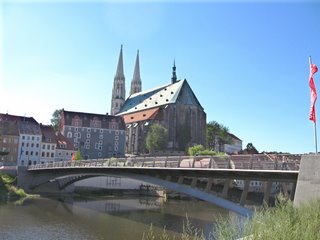 Görlitz seen from Zgorzelec across the footbridge with its customs control point
Görlitz seen from Zgorzelec across the footbridge with its customs control pointIt was twenty kilometres to the nearest campsite at Niesky. We found it without any problem and it is really pleasant. By contrast to last night this is set in a forest of silver birch, oak and pine trees. There are several small lakes here and we are camped beside one of these under a rowan tree with its clusters of orange berries. On the other side of the little lake a few naturists are camped. Today has been exceptionally hot and sticky so within minutes Jill was swimming in the lake which was blissfully cool and, except for three or four naturists and a few trout, quite deserted. Imagine the sheer pleasure of swimming in a cool lake with the setting sun raking through the leaves of the overhanging birch trees, climbing out feeling tingly fresh and padding back along the woodland path, dripping water as you go, to discover a table laid with glasses and a bottle of wine waiting for you! There are a couple of other camping cars nearby but otherwise we have this little piece of woodland to ourselves.
Wednesday 19th July 2006, Niesky, Oberlausitz, East Germany
Despite the little town of Niesky not even receiving a mention in our guide book it has turned out to be a very agreeable place with an interesting history. We are still here because it has been too hot to move on. We will probably be here tomorrow as well because temperatures of 38 degrees are forecast. Driving around in a camping car in such heat is not funny. Today, to prove a point, we put our thermometer out in the full sun for a few minutes. It rose from 33 under the trees and inside Modestine to 47.7 degrees.
The lake and the trees mean we can find some shelter here and cool off easily. Even Ian has been rushing to the lakeside today! It takes him a little time at the water's edge to actually get in, but today Jill's encouraging tones were helped by a cheerful German lady who threw water over him from behind.
After lunch we cycled the few kilometres into town through the woods and along a cycle track. By the time we arrived we were uncomfortably hot and sticky. At the museum we sought protection from the heat in a cool house constructed from wood. Here we learned that the town only came into existence in 1742 when settlers from Bohemia, the Herrenhut Bretheren, arrived having been driven out of their homeland by the Catholics. Here they were granted land by a local aristocrat and set up their own community, constructing a model town around a central square with gardens and a church. The result today is a spacious and attractive town with gardens and open spaces. The original first house in the community is now the museum.
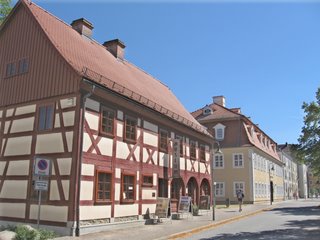 First house built in Niesky in 1742, now the museum
First house built in Niesky in 1742, now the museumNext door is the library. This is also in an old wooden building but has been renovated to provide an enviable little library full of bright books, videos and cassettes. It does not however provide suitable access to the internet and staff assured us nowhere else in Niesky did either. Ian commented that it seemed strange that they were still using the old DDR classification system for their bookstock. Poor librarians! One wonders how often a German speaking British tourist questions the value of their classification scheme in a little, off the beaten track library like this!
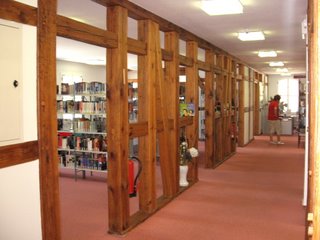 The library, Niesky
The library, NieskyLater, at the tourist information office we again asked about internet access. Nowhere gave it officially but we were directed to the town's industrial estate with the name of a company and told to ask for Frau Dingsbums. As we cycled along a dusty track in the heat of the afternoon in the vague hope of finding somewhere to load on a new page we discovered yet another manhole cover! You are probably not as excited about it as we are but here it is! It must be a rarity to find such a thing in a little town that doesn't even make it into guide books!
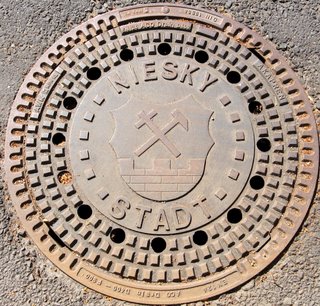 Manhole cover, Niesky
Manhole cover, NieskyEventually, right in the heart of the little industrial complex, between the tyre company and the express delivery depot, we discovered "Niesky Internet Zentrum". Inside the air conditioning felt like a fridge and all the rivulets of perspiration trickled cold down our faces.
The place was devoid of customers and the lady looked very doubtful when we asked for internet access. Apparently it is a resource intended for training purposes. However, she good-naturedly let us spend the rest of the afternoon in her air conditioned office with the use of her high-speed internet connection. When we went to pay she said she didn't have a clue how much to charge as they didn't offer a service so suggested nothing as a convenient round figure! So often as we travel around we meet with such spontaneous kindness from people! Ian had a bit of a chat, explaining what we were doing with the internet and we left with her wishing us well on our onward travels.
On the way back to the camping place we stopped for ice creams by the town swimming pool, watching the many children cooling off and having fun in the water. Back at our shady woodland grove we did the same, cooling off and having fun in the water until it was cool enough to prepare supper and sit outside in the darkness. Will we be able to sleep in Modestine? It is still 29 degrees at 9.30pm.Last night we risked an invasion by armed hedgehogs, stoats, weasels and other denizens of the wild wood, sleeping with the back door wide open. We will probably do the same tonight.
 Blogging in the gloaming, Niesky
Blogging in the gloaming, NieskyThursday 20th July 2006, Niesky, Oberlausitz, East Germany
As you see, we are still here. It is fortunate that the lady at the internet place yesterday warned us of the expected exceptionally high temperatures for today. She advised us to stay put in the shelter of the woods and it is fortunate we did. It has been SO uncomfortable. We understand that temperatures in Britain have reached an all-time high today too. Our problem is that we have nowhere under cover to seek shelter and it could honestly be quite dangerous. Imagine being caught in a traffic jam on the ring road around Berlin in temperatures that are well up in the 40s! This is what would have happened to us if we had continued today. Instead we stayed put, Modestine with her blinds down and windscreen protected from the heat while we moved our chairs from tree to tree as the sun encroached relentlessly throughout the day. Whenever it became unbearable we padded to the water's edge and hurled ourselves in amongst the pike and minnows.
It has been too hot to do anything except sit drinking endless glasses of chilled water and checking the thermometer every few minutes. It has risen steadily, registered in the same spot, from 29 degrees at 8.30am to 38 around 2pm. In the sun it was obviously worse. It is now 9.30pm and it has dropped back down to 30 so we can expect another uncomfortable night.
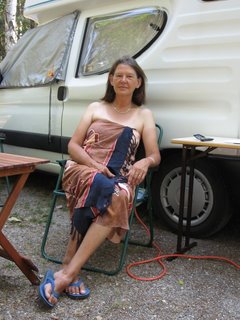 Too hot to move, Niesky
Too hot to move, Niesky Ian by the lake, Niesky
Ian by the lake, NieskyIan has managed to read a complete crime novel in German today as well as swimming a couple of times so that's something achieved. We have also used the washing machine in the wooden hut in the woods, hanging out our wet bedding to dry between a couple of trees by the lakeside.
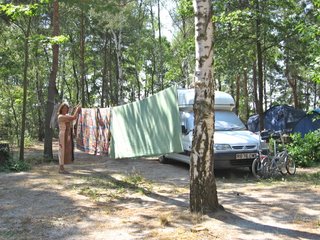 Hanging out the washing, watched by Modestine, Hinge and Bracket, Niesky
Hanging out the washing, watched by Modestine, Hinge and Bracket, NieskyWe mentioned earlier that this site is also used by naturists. They have their own area just a few metres across the lake from us and we cannot fail to notice their naked forms as they climb in and out of the water. As we were cooling off in the lake this morning there was shouting and barking from within the trees on the opposite bank. Seconds later a rather corpulent German man wearing nothing but long locks and a sunhat came tearing out of the bushes in pursuit of his tiny yapping terrier which was in turn chasing after a much larger dog. It must be a risky undertaking separating a couple of fighting dogs when you are starkers! By the time they were parted even the sunhat had come off! Gathering up his little dog and his hat, we watched from the cool of the lake as the owner's pale pink backside retreated into the undergrowth.
So that has been our day. It has been the most difficult to cope with throughout our travels but thanks to the lake and the trees we have managed to survive it okay. A cooler day is expected tomorrow and we really should be moving on.
